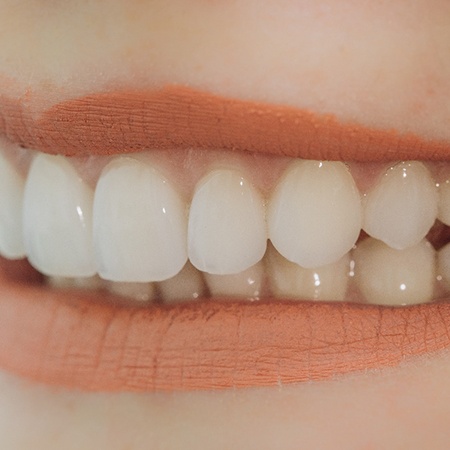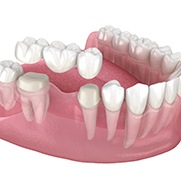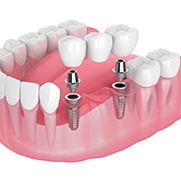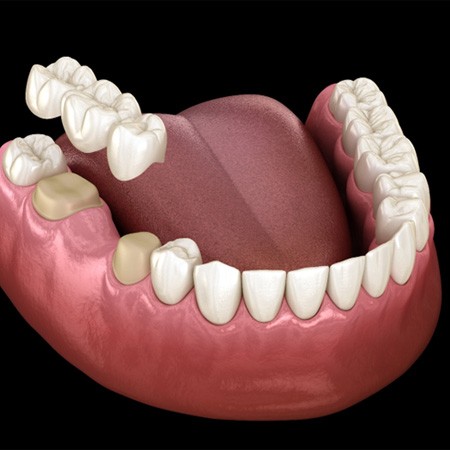Dental Bridges – Fresno, CA
Bridging the Gaps In Your Smile
Missing one or two teeth can take a huge toll on your self-confidence. Even if you can’t see the missing pearly whites when you smile, tooth loss still has a negative impact on your oral health. Not only will your teeth start to drift out of place, but your risk of issues like cavities and gum disease will increase. Fortunately, at Shinkawa Dental, we can seamlessly bridge the gaps in your smile with custom-made dental bridges in Fresno. These reliable restorations can fill in the space left behind by missing teeth in just a few weeks! Give us a call today to schedule your next appointment and learn more about getting a dental bridge.
What Is a Dental Bridge?

Essentially, a dental bridge is several dental crowns fused together to make a single apparatus. It will consist of one or more replacement teeth plus two more, one on each side. These two extra dental crowns are fitted over the remaining healthy teeth that used to neighbor the tooth or teeth that are now missing. They support the other dental crowns between them, effectively bridging the gap that was once in your smile.
Types of Dental Bridges

We offer two main types of dental bridges: traditional bridges and implant bridges. The one that will be best for you will depend on several factors, such as your oral health, jawbone density, and personal preferences. We’ll help you discover which type of bridge would be best for your needs once we’ve seen you for an evaluation.
Traditional Dental Bridges

Traditional bridges typically take about two appointments to receive. First, we’ll prepare the teeth on either side of the gap in your smile by removing a thin layer of enamel and taking impressions. Then, we’ll place a temporary restoration while the impressions are sent to a local dental lab to create your dental bridge. In about two weeks, you’ll return to our office to have your dental bridge bonded into place.
Implant Bridges

The main difference between traditional and implant bridges revolves around where they get their support from. Instead of relying on your remaining healthy teeth, an implant bridge is anchored onto a set of dental implants. These titanium posts are embedded into the jawbone like tooth roots, which provide a solid foundation for your new bridge. The process of getting an implant bridge spans several months, but the results have the potential to last a lifetime.
The Benefits of Getting a Dental Bridge

- Seamlessly replace your missing teeth
- Prevent dental drift and a misaligned bite
- Maintain better oral health
- Easy maintenance
- Long-lasting (15 years for a traditional bridge, 30+ for an implant bridge)
- Confidence in your smile
Dental Bridge FAQs

Dental bridges have been used to replace teeth for a very long time, but we know that many patients might still have some questions about them. Never hesitate to tell us if there’s something you want to know about a treatment we’ve recommended; we want to help you make the right decisions for your smile, and you can only do that when you’re fully informed about your options! Below are some common questions that we often hear from patients who are thinking about getting a dental bridge.
How Many Teeth Can a Dental Bridge Replace?
A traditional dental bridge can be used to replace as many as four teeth in a row. That said, longer dental bridges tend to be less stable, especially if the teeth supporting them aren’t especially healthy. As such, most dental bridges are only used to replace one or two teeth at a time. Bridges supported by implants tend to be more reliable thanks to the support they receive from the implant posts.
Can You Take a Dental Bridge Out?
Dental bridges are not like dentures; they are meant to stay in your mouth at all times. Your bridge should only be removed by a dental professional. If it does come out, that means something went wrong and you need to schedule an appointment right away.
Some patients get confused because certain healthcare providers refer to partial dentures as “removable bridges.” While partial dentures and bridges do have some similarities, bridges are specifically made to stay in place while partial dentures are designed to be taken out at any time. Furthermore, bridges only replace consecutive teeth, but partial dentures can be custom designed to fill in any number of gaps.
How Long Should a Dental Bridge Last?
The expected lifespan for any given dental bridge is somewhere between 5 and 15 years. While the material they’re made from can make a difference, the main factor is the kind of care you give it. If you want your bridge to last a long time, you need to practice good oral hygiene, eat smile-friendly foods that won’t damage your restoration, and drop any harmful oral habits like nail-biting or eating ice.
On average, bridges near the front of your mouth tend to last a little longer than those near the back of your mouth. This is because the front teeth aren’t subjected to as much wear and tear related to chewing.
Can Dental Bridges Get Cavities?
Dental bridges technically cannot get cavities. However, the teeth supporting them are still vulnerable to decay. You might develop a cavity in a tooth supporting a bridge if food debris gets trapped underneath the restoration, attracting bacteria to an area that’s difficult to reach with your toothbrush. You need to clean around and under your dental bridge thoroughly every single day if you want to protect your natural teeth from cavities. If your bridge is particularly old, keep an eye out for cracks in the cement holding it in place. Said cracks could increase your risk of decay in the underlying teeth.
